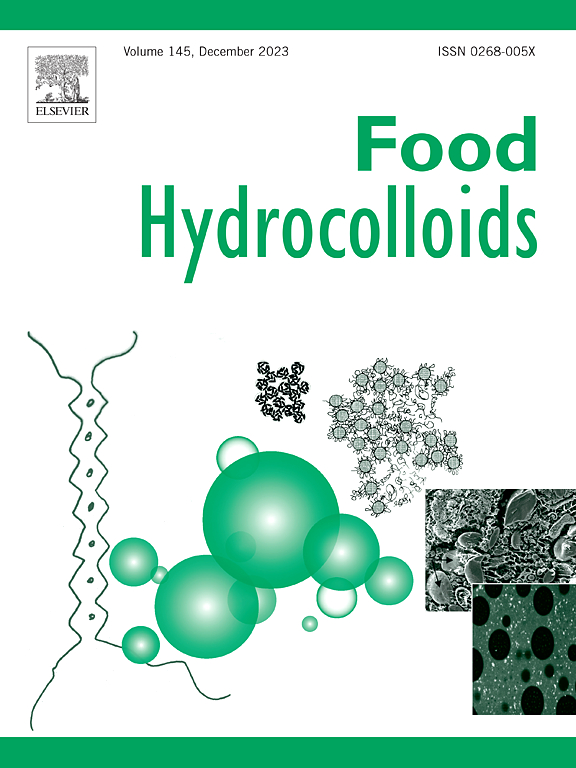Plant-based hydrogel beads for vitamin D bioaccessibility: The role of protein denaturation and dimension
IF 11
1区 农林科学
Q1 CHEMISTRY, APPLIED
引用次数: 0
Abstract
Encapsulating bioactive components within hydrogel beads provides an effective method of improving their stability and efficacy, thereby enhancing their potential health benefits. In this study, vitamin D3-loaded nanoemulsions were encapsulated within plant-based hydrogel beads comprised of pea protein (heated or unheated) and calcium alginate. The impact of bead composition and dimensions on lipid digestibility and vitamin D bioaccessibility was then investigated. The hydrogel beads containing heated pea protein were more stable to simulated oral and stomach phases than those containing unheated pea protein. This effect was attributed to the formation of heat-induced pea protein aggregates that were better retained within the calcium alginate network inside the beads. The bioaccessibility of vitamin D3 was improved when it was encapsulated within the beads, which may have been due to their ability to protect the vitamin from chemical degradation, especially under acidic gastric conditions. The beads containing the heated protein provided the best protection during stomach digestion, leading to around 86 % of the original vitamin D3 still being bioaccessible after the small intestine phase. The results of this study may lead to the development of novel hydrogel delivery systems that can improve the efficacy of oil-soluble vitamins in plant-based foods.

植物基水凝胶微球对维生素D的生物可及性:蛋白质变性的作用和尺寸
将生物活性成分包埋在水凝胶珠内提供了一种提高其稳定性和功效的有效方法,从而增强了其潜在的健康益处。在这项研究中,负载维生素d3的纳米乳液被封装在由豌豆蛋白(加热或未加热)和海藻酸钙组成的植物基水凝胶珠中。研究了猪头组成和尺寸对脂质消化率和维生素D生物可及性的影响。含有加热过的豌豆蛋白的水凝胶珠比含有未加热过的豌豆蛋白的水凝胶珠对模拟口腔和胃相更稳定。这种效应归因于热诱导的豌豆蛋白聚集体的形成,这些聚集体被更好地保留在珠子内部的海藻酸钙网络中。当维生素D3被包裹在微球内时,它的生物可及性得到了改善,这可能是由于它们能够保护维生素免受化学降解,特别是在酸性胃条件下。含有加热蛋白质的微球在胃消化过程中提供了最好的保护,导致大约86%的原始维生素D3在小肠期后仍然是生物可及的。这项研究的结果可能会导致新的水凝胶递送系统的发展,可以提高植物性食物中油溶性维生素的功效。
本文章由计算机程序翻译,如有差异,请以英文原文为准。
求助全文
约1分钟内获得全文
求助全文
来源期刊

Food Hydrocolloids
工程技术-食品科技
CiteScore
19.90
自引率
14.00%
发文量
871
审稿时长
37 days
期刊介绍:
Food Hydrocolloids publishes original and innovative research focused on the characterization, functional properties, and applications of hydrocolloid materials used in food products. These hydrocolloids, defined as polysaccharides and proteins of commercial importance, are added to control aspects such as texture, stability, rheology, and sensory properties. The research's primary emphasis should be on the hydrocolloids themselves, with thorough descriptions of their source, nature, and physicochemical characteristics. Manuscripts are expected to clearly outline specific aims and objectives, include a fundamental discussion of research findings at the molecular level, and address the significance of the results. Studies on hydrocolloids in complex formulations should concentrate on their overall properties and mechanisms of action, while simple formulation development studies may not be considered for publication.
The main areas of interest are:
-Chemical and physicochemical characterisation
Thermal properties including glass transitions and conformational changes-
Rheological properties including viscosity, viscoelastic properties and gelation behaviour-
The influence on organoleptic properties-
Interfacial properties including stabilisation of dispersions, emulsions and foams-
Film forming properties with application to edible films and active packaging-
Encapsulation and controlled release of active compounds-
The influence on health including their role as dietary fibre-
Manipulation of hydrocolloid structure and functionality through chemical, biochemical and physical processes-
New hydrocolloids and hydrocolloid sources of commercial potential.
The Journal also publishes Review articles that provide an overview of the latest developments in topics of specific interest to researchers in this field of activity.
 求助内容:
求助内容: 应助结果提醒方式:
应助结果提醒方式:


